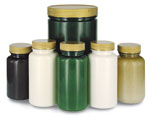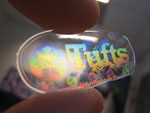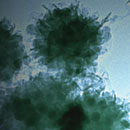
Technologies that target food safety, packaging sustainability, product quality and operational efficiency are recreating the packaging business. How will they give you an edge?
Packaging technology, which has advanced profoundly in the past 50 years, stands poised to make even greater leaps. Key drivers include the sustainability movement; fears about food safety; consumer demand for better tasting; more convenient products; and food processors’ desire to differentiate using packaging.
Myriad research and development projects, many still in the lab, are addressing these issues. The result will be a new generation of packaging materials and structures that deliver more functionality and consumer appeal, along with substantial gee-whiz value.

These bottles are made from a polylactic acid (PLA) composite resin that incorporates a mineral component. The result is better oxygen and moisture barrier, strength and heat stability than pure PLA.
Photo courtesy of Earth RenewableTechnologies LLC
Photo courtesy of Earth RenewableTechnologies LLC
1. SUSTAINABLE PACKAGING
Improving the performance ofpolylactic acid (PLA)to protect food more effectively, in a broader range of conditions, is one focus of the many sustainable packaging projects underway in industry and academia. PLA is a biopolymer derived from renewable resources such as corn.Improving impact strength, flexibility and temperature resistance is the goal of an emerging line of food-gradePLA modifiers. The heat-stabilizing modifier increases the dimensional stability of PLA packaging materials to temperatures up to 203° F. (95° C.), opening the door to non-chilled food applications.
Work continues, separately, to improve the barrier properties of cellulose films. The films are produced from sustainable wood pulp and are home compostable and biodegradable. The developer of a recently commercializedhigh-barrier cellulose filmclaims the new film’s moisture barrier approaches that of coextruded oriented polypropylene and that it offers excellent oxygen barrier properties.
Renewable packaging materials that leverage the properties of clay and stone are another area of inquiry. Examples include apaper derived from limestonethat demonstrates excellent moisture barrier.
A different approach, which could increase moisture and oxygen barrier in biodegradable films, usesultrasonic atomization spraying technologyto coat the films with clay nanoparticles.
Developmental work with conventional polymers also has gone green.Oxo-biodegradable technologyuses resin additives to enable polyethylene terephthalate (PET) to degrade in a landfill in 5 to 15 years-considerably faster than regular PET. Or the material can be disposed of via conventional PET recycling.
Complementing the materials-development projects are technologies that aid waste management companies. Optical sensors are the hot spot here, with increasing interest innear-infrared (NIR) spectroscopy. Different polymers, including PLA, have their own NIR fingerprint, making it possible to more effectively sort incoming plastics.

A holographic optical sensor made of pure silk fibroin could be used to create an edible in-pack bacteria detector.
Photo by Fiorenzo Omenetto, courtesy of Tufts University
Photo by Fiorenzo Omenetto, courtesy of Tufts University
2. ANTI-MICROBIAL PACKAGING
Technologies for killing microbes on food, packaging and equipment are developing in multiple directions. One sterilization technique that holds promise as an alternative to retorting is pressure-assisted thermal sterilization (PATS).PATS combines mild heat with high pressure to produce commercially sterile low-acid food products. The process significantly improves the quality of thermally processed foods while eliminating food safety risks from the bacteria that cause botulism, a major concern in low-acid food processing.
A research consortium that includes the packaging and food industries and the U.S. Army Natick Soldier Research, Development and Engineering Center (RDEC), recently filed apetition with the FDAfor the commercial use of PATS. The filing was for mashed potatoes in a pouch.
C. Patrick Dunne, Ph.D., senior advisor in advanced processing and nutritional biochemistry for the Department of Defense Combat Feeding Project of RDEC, says his team will conduct shelf life testing and military field tests on the pouches.
“It will take a couple years for large-scale production,” Dunne adds. “The equipment for large-scale PATS production needs to catch up.”
Meanwhile, irradiation research is delivering results in the area ofX-ray irradiation. Researchers report that X-raying is gentler than methods such as electron beam irradiation and can therefore be used on a greater range of foods.
On the packaging materials side, an array of anti-microbial materials are in development. Some are edible, and several leverage the anti-microbial properties of natural components such as oregano oil, cinnamon oil,grapefruit seed extract and green tea extract.
In-package pathogen detection may take a new turn in coming years, thanks to optical sensor technology that incorporates silk-based optics. Anedible, optical bacteria sensorcould be created using the technology, which is in development at Tufts University.
Methods for eradicating microbes from packaging equipment also are evolving. Onecoatingthat can be used on machine surfaces incorporates silver, a highly effective anti-microbial agent. The coating releases silver ions, which attack microbes and inhibit growth.

Printed electronic technology could bring light-activated power to packaging applications.
Photo courtesy of Konarka
Photo courtesy of Konarka
3. ELECTRONIC PACKAGING
Two of the hottest research areas in electronically enhanced packaging are printed electronics and mobile telephony. Printed electronics refers to printing conductive ink on a flexible substrate to create a very thin electronic device or circuit.Duracell already uses electronically printed labels as battery testers on Duracell PowerCheck batteries. In this case, the label is part of the product.
Packaging applications for printed electronics include self-monitoring sell-by-date labels; scrollable, font-adjustable package instructions; aroma-emitting labels; talking packages; and packs that present moving images.
Corralling the cost of printed electronics will enable its general adoption for packaging. The cost tide already is turning. For “the battery testers and some sensors that detect tampering electronically, the billion units a year level has already been reached at a unit price of a few cents,” says Peter Harrop, Ph.D., chairman ofIDTechEx.
Affordable power sources for on-pack printed electronics also are needed. Research from the military and industry suggests that harvesting energy from ambient sources such as the sun or artificial lights may be the answer.
One project funded in part by the U.S. Army has yieldedspray-on solar cellsthat convert sunlight into electricity. The cells, which are smaller than the head of a pin, can be sprayed or painted onto flexible substrates.
Another research initiative, at the Massachusetts Institute of Technology (MIT), has generated prototypes ofhighly efficient thin solar cells. The MIT team created a solar cell that uses anti-reflective coatings and a diffraction grating on ultra thin silicon film. The cell’s energy output is 50% greater than a conventional solar cell, and the thin film uses about 1% as much silicon, which is attractive from a cost standpoint.
In the mobile telephony arena, technology that lets cell phone users scan bar codes is preparing to reshape the shopping experience. Improved cell phone cameras are surmounting the problem of blurry, unscannable bar code photos, a problem that has held back mass-market mobile bar code scanning. Applications formobile scanninginclude in-store price checking and instant access to product information and promotional offers, including coupons.

This photo of polymer particles coated with silica-based nanoparticles was taken with a transmission electron microscope.
Photo courtesy of the University of Warwick
Photo courtesy of the University of Warwick
4. NANOTECHNOLOGY
Food packaging applications are a prime focus for research in nanotechnology, a science that uses submicron-size structures to change material properties, such as but not limited to boosting gas barrier. Military researchers are working with nanocomposites to create a non-foil pouch robust enough to replace the conventional retortable, foil-laminated Meal, Ready-to-Eat (MRE) pouch.The same team also has created a high-oxygen barrier bag from a nanocomposite of low-density polyethylene (LDPE). The bag holds the various retorted and non-retorted components included in an MRE.
For the MRE meal bags, “We have successfully manufactured LDPE nanocomposites, and we’re in the process of testing these materials to see if this is something that could be fielded,” says Jeanne Lucciarini, team leader of the advanced materials engineering team, Combat Feeding Directorate, U.S. Army Natick Soldier Center.
The team currently is conducting storage studies and rough-handling tests on 15 pallets of the filled, sealed meal bags. The military shelf-life requirement is three years at 80° F.
Natick’s materials group also is working to improve the barrier characteristics of ethylene vinyl alcohol (EVOH) by adding clay nanoparticles to the polymer matrix. The objective is an EVOH nanocomposite suitable for both retorted and non-retorted MRE packaging.
In the United Kingdom, research chemists at the University of Warwick are making news with a cost-effective and efficient process for covering small particles of polymer with a layer of silica-based nanoparticles.
The resultingpolymer latex materialcould be used to improve label adhesives and to create packaging with tailored oxygen and moisture-vapor transmission rates. It could also be deployed to enhance biodegradable packaging materials without sacrificing their eco-friendly character, because the nanoparticles are derived from clay and sand.
Back in the United States, a nanotechnology research team at Case Western Reserve University has developed a way to boost the gas barrier of polymer films and make them stronger, while using less resin than conventional films.
The team’shigh-barrier filmis made via layer-multiplying coextrusion, which generates nanolayers of crystallized polyethylene oxide (PEO). The PEO’s tight crystalline structure makes the film’s gas barrier hundreds of times greater than conventional polymers.

Cured gel ink technology will make it possible to use digital printing on virtually any surface.
Photo by Kevin Rivoli, courtesy of Xerox Corp.
Photo by Kevin Rivoli, courtesy of Xerox Corp.
5. DIGITAL PRINTING
The evolution of digital printing continues apace. Ink jet-based digital printing holds special interest for the future, with faster printing speeds and next-generation ink systems turning heads.Dan Marx, vice president, markets and technologies, at the Specialty Graphic Imaging Association, likens the technology curve in ink jet printing to the exponential growth rate of computer technology. “Ink jet has been really tracking with that in terms of its production speed, which has grown immensely,” he says.
Digital printing offers several benefits versus conventional printing technologies. It can be used to print variable data and images, and the minimal make-ready time for digital printing makes short runs economical. These advantages, combined with higher speeds, will increasingly position ink jet technology as an attractive option for online, on-demand food and beverage package printing.
Ink systems that will make ink jet more suited to these applications also is in development. These include acured gel ink technologythat’s compatible with materials such as foil and plastic films.
The gel ink has the consistency of peanut butter initially but becomes rock hard when exposed to a pulse of ultraviolet light. The print result is a crisp image that’s durable enough for packaging and labels.
Unlike water- or solvent-based inks, the gel ink does not require dryers and vapor recovery systems. This aspect is expected to increase print speeds even as it makes the system more environmentally friendly.
A FEW MORE AREAS TO WATCH…
Food PreservationNew technology for modified-atmosphere packaging (MAP) is making it possible to useMAPeven for delicate products like cherry tomatoes, salads, tofu and baked goods by eliminating the vacuum step. The equipment is reportedly faster than conventional MAP sealers, as well.
To assure cold chain integrity, University of Rhode Island researchers teamed up with a food safety company to develop acolor-changing bar code labelthat provides a visual cue if temperature abuse occurs.
Two bar codes are printed on the label, using thermochromic ink. If the cold chain is breached, a portion of the primary bar code turns magenta, rendering the code unreadable. At the same time, the second bar code becomes readable but when scanned delivers an error message. The labels are currently in pilot testing. Project cost is about four cents per label.
Optimization/Simulation Software
The ever increasing capabilities of computer hardware and software are speeding up all parts of package development, from structural engineering to graphic design.
Package engineers will benefit from advances in thefinite element analysis and modelingtools used by the aerospace, automotive and manufacturing industries. Improved tools will fuel more sophisticated approaches to virtual package prototyping and virtual stress testing.
In another area, software that leverages the internet to gain consumer feedback on alternative package designs is taking the subjectivity out of new product launches and package redesigns.
The technology usesevolutionary optimization, which combines a simple consumer exercise with a sophisticated, behind-the-scenes evolutionary algorithm. The software algorithm can search large ranges of concept alternatives using real-time consumer choice data to migrate to progressively stronger combinations of package elements.
Holographic Imaging
Taking a page fromStar Trek: The Next Generation, with its three-dimensional holodeck, marketers in coming years will be able to perform remote consumer research using holographic versions of their products.
Amobile handsetthat can capture, send, receive and project three-dimensional images has already been developed. The images are delivered in three-dimensional form using a projector. The handset is expected to become commercially available by 2010.
Heating Technologies
Advances in heating are driving packaging developments, including a novelself-heating food packaging technologythat’s based on a low-cost, food-safe solid-state fuel.
Still in development, the package is compact and lightweight. It heats food in its container simply, safely and efficiently using a flameless thermal reaction. Initial applications will be ready-to-serve soups and gourmet coffees. Full-scale production of the packages should begin by 2011.
Separately, packaging changes will ripple out of recent improvements in microwave cooking technology. A newly commercializedmicrowave oven operating systemcalled TrueCookPlus, from Microwave Science JV LLC, improves microwave results by using pre-programmed codes that combine multiple power levels during the cook time.
The codes for many products can be found at the developer’s web site and/or printed on food packages. To leverage the technology’s cooking intelligence, packagers will need to rethink existing microwave susceptor designs. “TrueCookPlus is a game changer for susceptors. Perfecting the shapes and geometries [of packages and susceptors] becomes much more worthwhile,” says Steven Drucker, founder of Microwave Science.
Robotics
Inrobotics technology, refinements will occur organically over time as food and beverage packagers continue to ask for custom robotic solutions for picking, packing and palletizing.
One particularly challenging application-mixed-load, multi-product palletizing-is spurring more sophisticated programming for robots.
In addition, a greater range of end-of-arm tools will be needed to meet the specific needs of food processors. Tools that can handle non-uniform food products with precision and at high speeds will be an integral part of tomorrow’s custom robotic solutions.
Video Diagnostics
Equipment diagnostics will continue to benefit from the trend toward wireless communication.
One commercially available system puts a video camera and microphone on ahardhatso the equipment manufacturer’s service manager, who may be anywhere in the world, can see what the plant technician sees and talk the technician through the repair. Real-time, hands-free communication via the internet makes diagnostics easier and faster.
Another approach is to permanently mount a video camera on a piece of equipment. Ashrink wrapperdesigned with this feature incorporates a camera that can zoom in or out, tilt and pan. Remote control of the camera, again via the internet, is possible.
High-speed motion analysis is improving, as well, thanks tovideo technologythat records continuously but saves only the footage relevant to machine malfunctions.
Systems Integration
Expect plug-and-play connectivity for packaging machines to be commonplace in the future. TheOrganization for Machine Automation and Control (OMAC)Packaging Working Group has written a set of guidelines and standards to simplify customization and integration of packaging equipment. When the standards become widely implemented, operational efficiency and flexibility will increase even as systems integration costs shrink.

